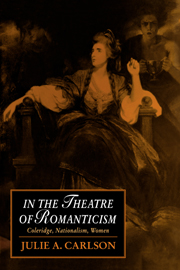Book contents
- Frontmatter
- Contents
- Acknowledgments
- List of abbreviations
- Introduction: Commanding genius in English romantic theatre
- 1 Constituting bodies politic and theatric
- 2 Coleridge's German revolution: Schiller's Wallenstein
- 3 A stage for potential men
- 4 Romantic antitheatricalism: surveilling the beauties of the stage
- Conclusion. A theatre of remorse
- Notes
- Index
Introduction: Commanding genius in English romantic theatre
Published online by Cambridge University Press: 12 September 2009
- Frontmatter
- Contents
- Acknowledgments
- List of abbreviations
- Introduction: Commanding genius in English romantic theatre
- 1 Constituting bodies politic and theatric
- 2 Coleridge's German revolution: Schiller's Wallenstein
- 3 A stage for potential men
- 4 Romantic antitheatricalism: surveilling the beauties of the stage
- Conclusion. A theatre of remorse
- Notes
- Index
Summary
… Share with me, Friend! the wish
That some dramatic tale, endued with shapes
Livelier, and flinging out less guarded words
Than suit the work we fashion, might set forth
What then I learned, or think I learned, of truth,
And the errors into which I fell
(The Prelude, xi. 282–7)In the Theatre of Romanticism dwells on the wish embedded in this narrative of the growth of a romantic poet's mind. It sees as characteristic Wordsworth's wish for drama in recounting his experience of the French Revolution and analyzes the impulse toward theatre in all five of the canonical poets when accounting for their illusions regarding national and aesthetic reform. Not only “less guarded” words but “livelier shapes” enhance the fancy-work of refashioning individual patriots and collective dreams. But this book also sees as symptomatic the disavowal of drama and theatre accompanying virtually every romantic accounting of mind. For Wordsworth's wish ignores the site that perpetually reveals the “errors into which [he] fell,” not simply in applauding the drama unfolding in France but anticipating applause first at Drury Lane and then Covent Garden for his tragedy The Borderers. In linking revolution and drama, the wish of The Prelude captures the canonical poets' reactions to both. Their imagined futures recompose the past: either past errors in endorsing revolution and the stage (the task of the first generation), or errors of the past that, according to the second generation, necessitate social revolution and theatrical reform.
- Type
- Chapter
- Information
- In the Theatre of RomanticismColeridge, Nationalism, Women, pp. 1 - 29Publisher: Cambridge University PressPrint publication year: 1994



